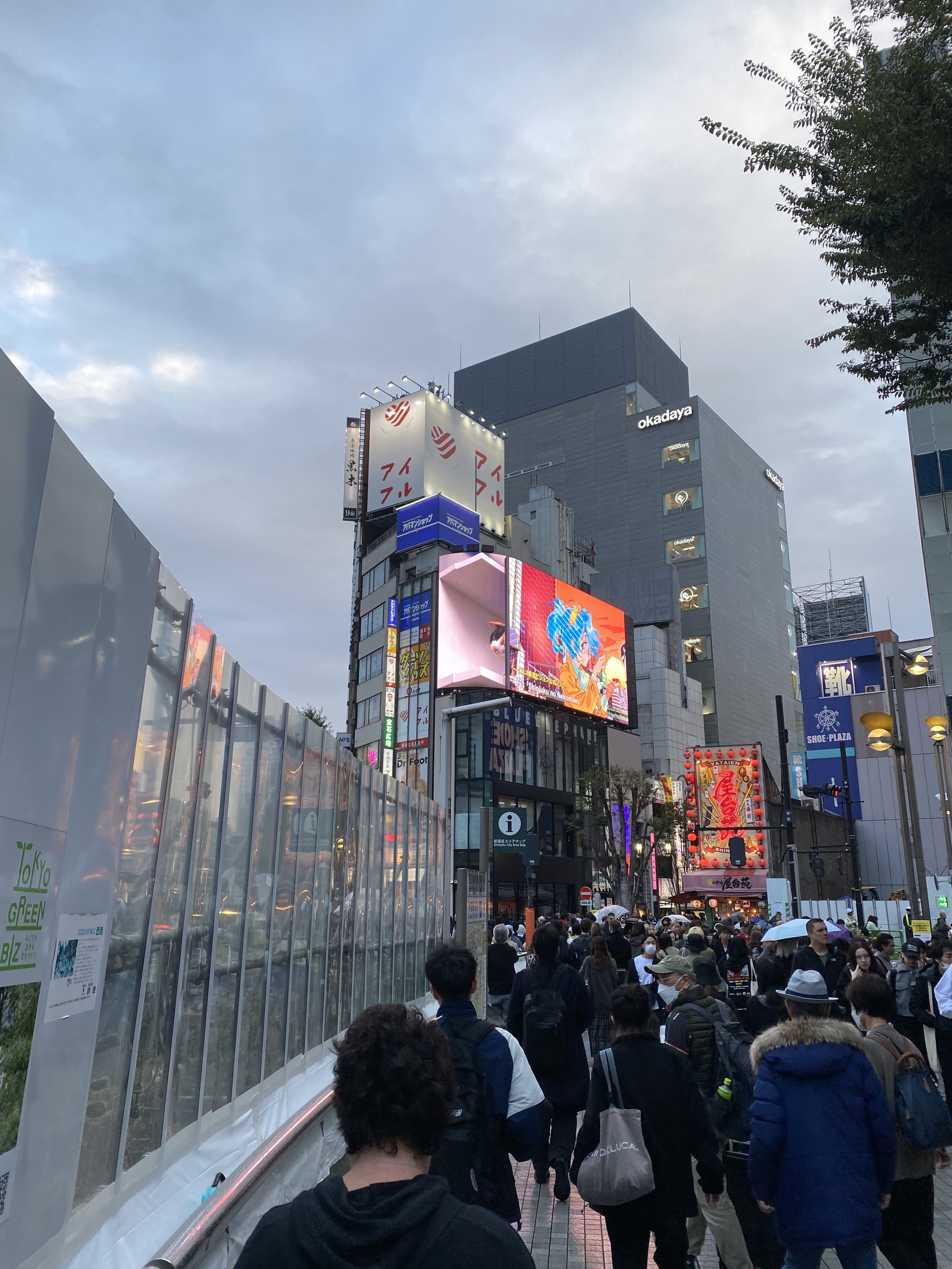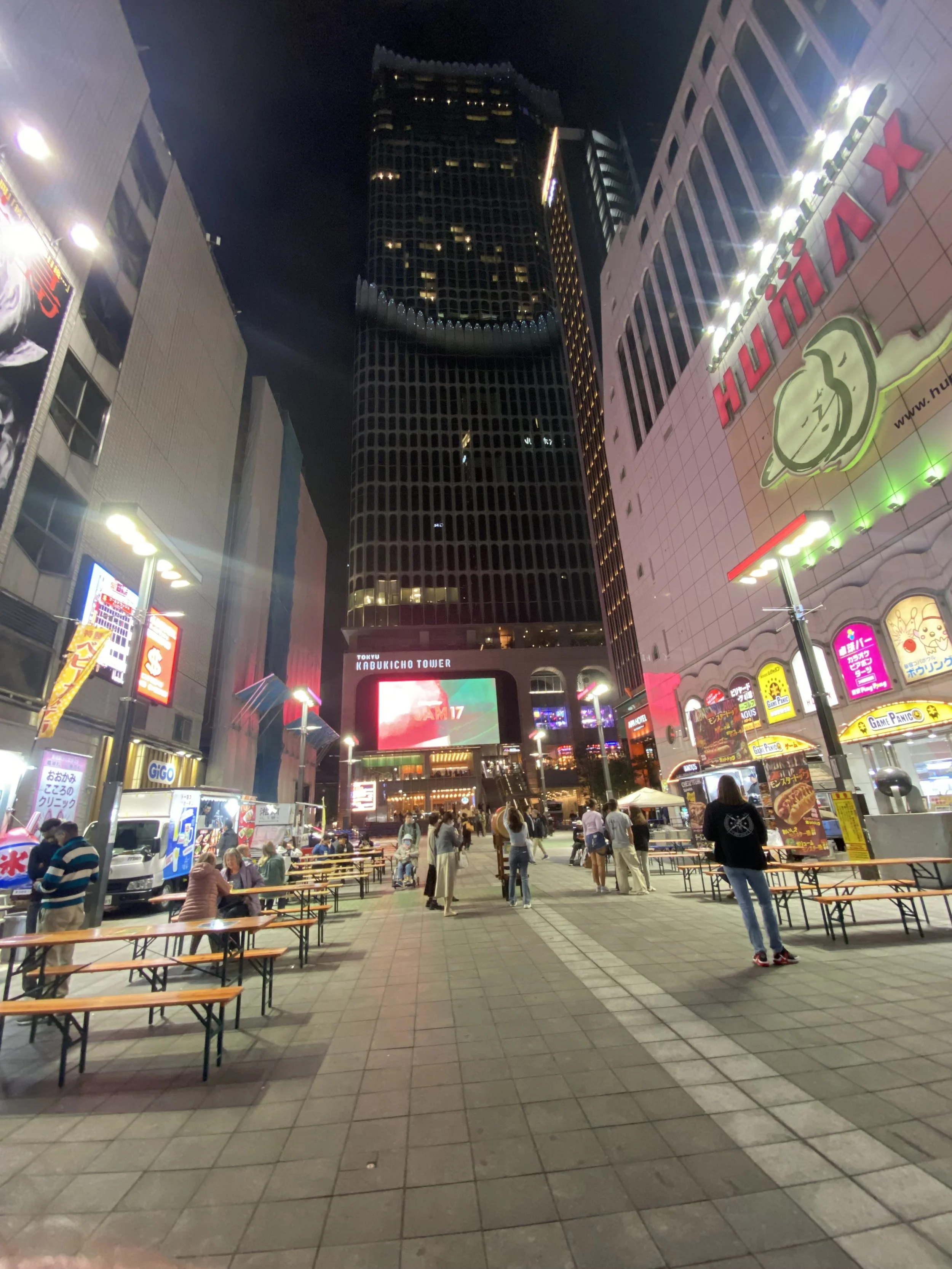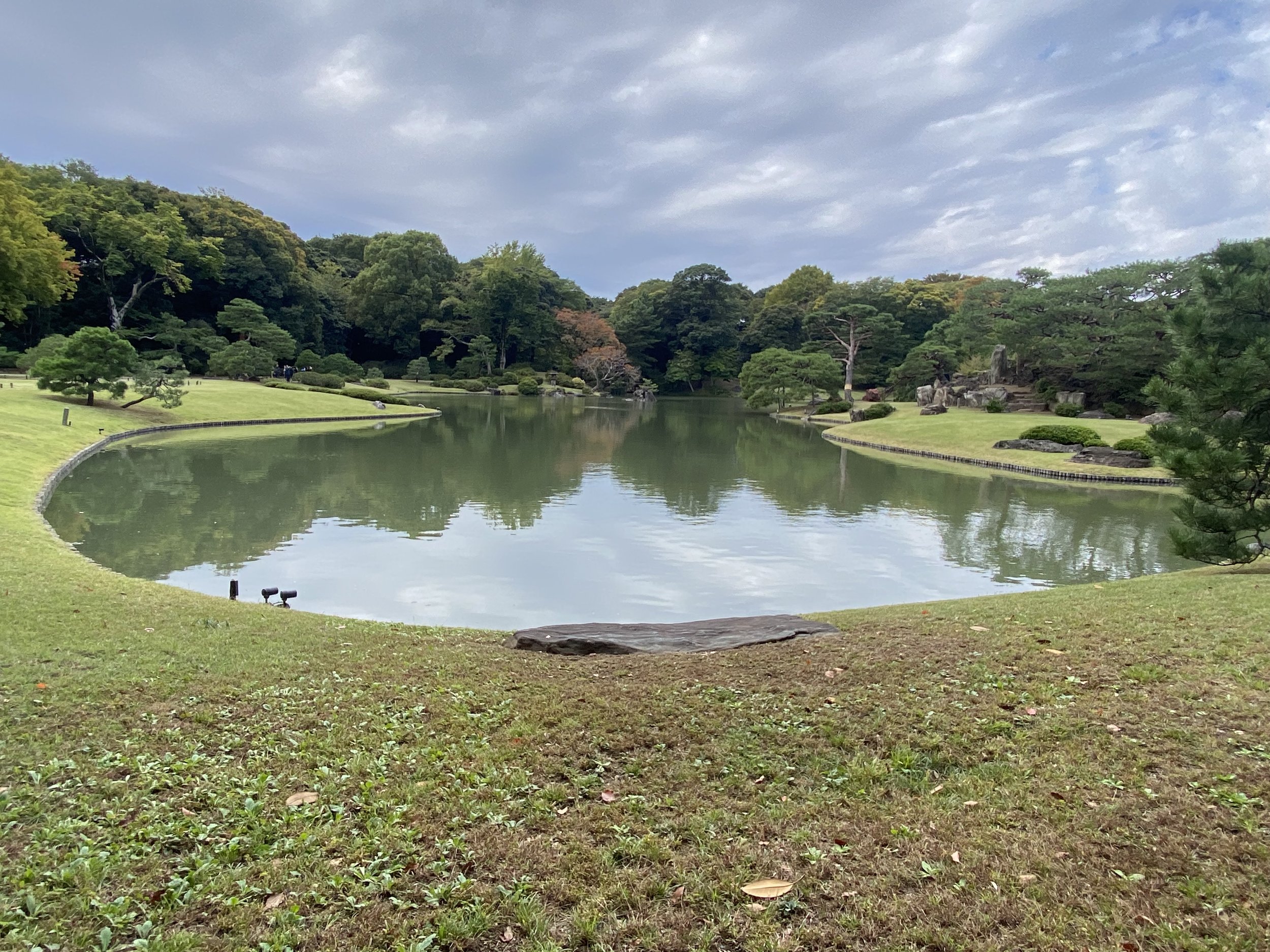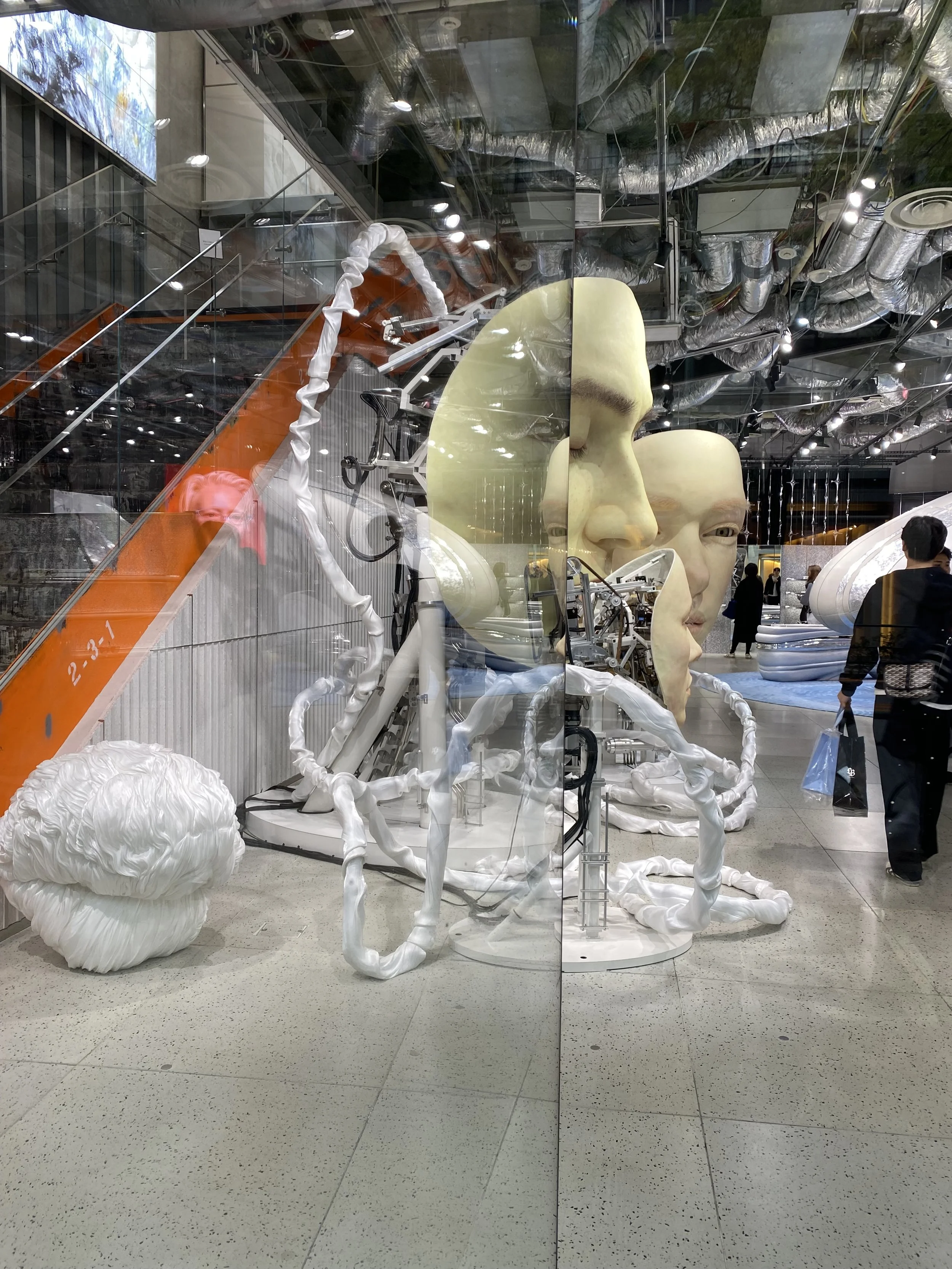Tokyo 東京
23rd - 25th October
Green class travel on the Azusa Express Train to Tokyo today which means nice comfy seats and plenty of room for luggage. The train system in this country is so well organised and on each platform there are markings on the ground showing the numbered carriage for every train that stops at that station. Marked queueing channels are marked so that it is clear where everyone should line up to wait for the train’s arrival. And everybody does, patiently and quietly. The trains arrive two minutes ahead on their departure time with scary accuracy and then, once people have got on and off, it leaves bang on time every time.
Inside Japan had booked our seats with the foresight on knowing that if we had the seats looking out to the South then we might get a glimpse of Mt Fuji as we approached Tokyo. The sky was clear so there was a reasonable chance.
Quick, there it is! Crowned with the first snow of the season.
Excitement over, the feast of the two and a half hour journey passed without incident.
The superbas of the world’s most populous city start a long long way out from the centre but it is not until we start to near the Shinjuko district where our hotel is that the high rise buildings really start to rise up.
And then, BAM! You’re in the heart of the metropolis.
If you had arrived here straight from the middle of London or Mexico City you might not find that you are just mildly taken aback about the noise and throng of humans here. If, like us, you’ve arrived from some small town in the middle of nowhere, it’s a massive wave of cultural shock. Every street is heaving and the noise of adverts on huge screens, traffic, trains and people is totally mad.
The first thing that we see is a huge cat in 3D animation poking its head around a digital advertising hoarding above us meowing loudly just to make sure that everyone looks up.
Our hotel is fifteen minutes walk and is easy to find because in a city with massively tall buildings, the hotel Groove is in one of the tallest.
Preferring to have separate beds, Pauline changed our Deluxe King for a triple. Well at least we had somewhere to put our big cases that we were now reunited with.
We went out early evening to get some food and found that our hotel was in the middle of the red light district. Odd!
For the first time in four weeks we felt a little uneasy but still not really threatened and everyone seemed to be going about their business in a calm manner.
Pimp in the foreground here. We had gyoza in the corner restaurant a few blocks down on the right. This was the highlight of our participation in the local nightlife and we turned in early, again, to enjoy the comfort of a modern hotel before taking our guided cultural tour the following day.
This is the view from our hotel window that I ‘enjoyed’ from the early hours of the following morning once the train started running at 5.00am. I had several hours to reflect on how the Japanese standards for sound control in hotel construction fell very far short of what would be expected by Premier Inn in London before Pauline awoke.
Japan’s capital city wasn’t always like this, in fact it wasn’t even the official capital until the end of the Edo period in 1868. Before then it was called Edo. Confused yet?
Edo ( literally ‘gate of the river’ )was just a small village before the warrior poet Ōta Dōkan put up a castle here in the 15th Century. It was the warlord Tokugawa Ieyasu though that really put the place on the map when he split from the old power base of Kyoto in 1603 to set up his shogunate military government. The emperor who was now little more than a figurehead was left behind whilst Tokugawa ruled over the whole country. Mr T could see how the outside world was changing and he didn’t like it. He feared colonialism and the spread of Christianity and decided that from now on Japan was closed for business with anyone else on the planet. Thus the Edo period began.
Isolation continued through for more than two hundred and fifty years until bully boys from the US turned up in a bunch of black ships and muscled their way in to get an unequal trade deal. All sounds a bit familiar doesn’t it with dementia Don chucking his not inconsiderable weight around the world markets right now.
Power was given back to the emperor in Kyoto but Edo remained the designated capital and was renamed Tokyo which literally translates to East Capital. Subtly, you might have noticed that Kyoto (translates to ‘capital city’) has the same two syllables but in reverse but the Kanji characters for the ‘Kyo’ bit are different as is the literal translation. Baffling!
After a breakfast that knocked the knocked the crap one at Matsumoto into touch we met our guide for the day that had been pre booked by Inside Japan. Masa Hattori (the guy on the left in the picture above) may or may not be descended from the famous Samurai warrior Hattori Hanzo but nonetheless he is a pretty cool guy. Aged 78, he treks around Tokyo four or five times a week showing tourists around his city.
Here he shares a metro seat with a young girl who has clearly had a long night out in the tiles and is sleeping it off on the Yamanote loop line.
Masa looked a bit forlorn when we said that we has seen enough shrines and temples whilst being in Japan and that we also wanted to see things that were off the beaten track. He quickly adapted and took us to the wonderful Rikugien Gardens in the North of the city, a strolling garden so quiet that it doesn’t feature at all in TLP and was almost completely devoid of any other tourists.
Granted it wasn’t the most spectacular of gardens that we had seen but certainly fitted the brief. There were even a few maples that were starting to turn colour for us.
We did say that if we were to go to a temple/shrine then it would have to be the best that Tokyo had to offer so next stop was the Meiji Jingu gardens and shrine. This was the emperor that stepped in at the end of the Edo period and has a whole era of Japanese history named after him. By the end of his life in 1912 Japan had transformed from a medieval feudal society into an imperial power that had waged and won wars against its two biggest neighbours China and Russia. In a little over a quarter of a century, Japan had moved from a backward country that had been completely bypassed by the industrial revolution to a world power.
These sake barrels show all of the sponsors for the upkeep on the temple, shrine and gardens. They hope that their offerings will improve the rice yield and quality. Seems that they need to give out a. It more as the 2025 harvest has been terrible which has seen the base price for rice double this year.
Pretty impressive shrine complex
Because Meiji won Japan’s best ever emperor contest there is a national holiday on his birthday every year - 3rd November. There’s a big build up to this day and flowers are sent from towns and cities all over the country. Chrysanthemums are all the rage, some are huge and others like these bonsai ones are used to adorn cute little models.
We then went to material street where Pauline bought as much fabric as we could carry for a fraction of the price it would have been in the UK. She was happy enough to indulge me on the next destination of our tour - architect’s alley where the most famous international store indulge the whims of their chosen starchitect to spend copious amounts of money on shiny baubles to show off their baubles.
My favourite of course was the Tadao Ando arcade.
The Prada building by Herzog and de Mueron was also pretty funky
Make way for the shrine!
The out there features continue to the interiors.
Another Ando building to finish
We returned to the hotel via the city’s busiest crossing. We were so tired but it had been a great day and having a guide had made things a whole lot easier. Apart from anything else, we were pleased to have worked out how to use the transport network in the city. We did feel though that we could have had longer here as there are many more things to see than the tiny proportion of metropolis that we covered today. Still, we have one more night on the way back through at the end of the trip. Also, the big orange man is coming to town tomorrow so definitely time to be somewhere else. Anywhere else in fact.
It was raining in the evening so we didn’t venture more than a few paces from the hotel.
And tucked into a well earned burger and fries.


























